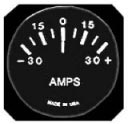What
Would You Have Done?
In this
"interactive" issue of Callback, several recent ASRS Reports
are presented in a format which allows the reader to consider an appropriate
course of action for a given situation. The reporters' actions, which
may or may not represent the best solution to the problem, are found
on the reverse of this Callback issue.
Situation
#1:
Main
Cargo Fire Warning
 On
a flight from Japan to the United States, a B767-300 was taking off
on a dry 12,000 foot runway in day VFR conditions.
On
a flight from Japan to the United States, a B767-300 was taking off
on a dry 12,000 foot runway in day VFR conditions.
- At
80 knots on the takeoff roll we received a momentary Main Cargo
Fire Warning. This included an Engine Indication and Crew Alerting
System (EICAS) message, Fire Bell, and Fire Lights....

Situation
#2:
A
Passenger Began Yelling
 A
B767 Flight Attendant
was seated for the takeoff and climb when a frantic call was heard.
A
B767 Flight Attendant
was seated for the takeoff and climb when a frantic call was heard.
- Approximately
five to ten seconds after takeoff, a passenger in my area began yelling,
"Baby, baby!" I released from my jump seat, crossed over
to the right aisle, and proceeded to where the passenger was yelling.
A female passenger was holding her 20 month-old infant boy, who was
limp, blue, and not breathing....

Situation
#3:
Complete
Electrical Failure
 The
pilot of a C182 obtained two weather briefings and an IFR clearance
prior to departing on a cross-country flight of approximately 130 nautical
miles.
The
pilot of a C182 obtained two weather briefings and an IFR clearance
prior to departing on a cross-country flight of approximately 130 nautical
miles.
- I
climbed without incident to 6,000 feet where I was in and out of the
cloud tops. About fifteen minutes into the flight, I noticed that
the ammeter was discharging. I could not reestablish operation of
the alternator. I contacted Center and declared an emergency. I was
given vectors to [an airport], cleared to descend to 2,100 feet, and
cleared for a GPS approach. While making the procedure turn inbound,
I began to experience icing, abandoned the approach, and climbed back
to 6,000 feet. I requested to fly to [my destination], where, hopefully,
I would be able to do an ILS or surveillance approach. I informed
Center that I would shut off all my electrical equipment to maintain
as much battery power as possible. I continued to fly in the general
direction of [my destination].... I turned the radio on and found
that I had experienced a complete electrical failure....

Situation
#4:
Controlling
an Emergency
 A
Sector Controller was confronted with adverse weather and conflicting
traffic when one of the aircraft approaching his sector declared an
emergency.
A
Sector Controller was confronted with adverse weather and conflicting
traffic when one of the aircraft approaching his sector declared an
emergency.
- Aircraft
X was Eastbound at FL390...deviating South of course for a thunderstorm....
As the Sector 35 Controller, I had approved FL390 WAFDOF (Wrong Altitude
For Direction Of Flight) due to weather, but new information on a
Westbound flight, also at FL390, deviating around the same storm,
prompted me to call Sector 32 to request Aircraft X at FL370 for the
traffic. Sector 32 advised that Aircraft X wanted to climb to FL410
with a 20-degree right turn for traffic. I approved the request. Later,
Sector 32 called to advise that Aircraft X had declared an emergency
due to engine failure and was descending to FL370, requesting FL240...

Situation
#5:
Under
a Time Constraint
 A
Maintenance Technician was assigned to fix an engine problem on a B737-800
scheduled for a short turnaround.
A
Maintenance Technician was assigned to fix an engine problem on a B737-800
scheduled for a short turnaround.
- The aircraft
called in with a #1 engine thermal anti-ice failure. I responded to
the call and began to work the problem.... With departure time approaching,
I decided to defer the nose cowl anti-ice system. The Minimum Equipment
List (MEL) Section 30 was used. Dispatch approval was required and
received.... A second maintenance technician brought the MEL paperwork.
He read the MEL requirements. We were under a time constraint, but
as the releasing Maintenance Technician, it was my responsibility
to insure that the MEL was complied with. Rechecking each step would
take some time....

The
Rest of the Story -
the Reporter's Actions
Situation
#1: Main Cargo Fire Warning
- Once
airborne in cruise flight, we coordinated with our dispatcher via
the Aircraft Communications Addressing and Reporting System (ACARS)
and the decision was made to divert to ZZZ1. We declared an emergency,
dumped as much fuel as possible, and then made an overweight landing.
After landing, the Main Cargo Fire warning illuminated again and remained
on until the aircraft was shutdown and secured. There was no sign
of smoke or fire.

The
Rest of the Story -
the Reporter's Actions
Situation
#2: A Passenger Began Yelling
- I
took him from her, put him face down on my left arm and performed
the Heimlich maneuver. He was still not breathing so I placed him
on the floor face up, tilted his head and administered two breaths.
[There was] no chest rise. I did the Heimlich on his diaphragm; still
no breathing. I tilted his head and did two more breaths. The child
coughed and began crying. A doctor onboard verified that the child
was OK.

The
Rest of the Story -
the Reporter's Actions
Situation
#3: Complete Electrical Failure
- Using
my cellular telephone, I first contacted Flight Service and then was
given a direct number to contact Approach Control. The controller
informed me that I was twenty miles east of [an alternate airport]
and suggested...that he could permit me to descend to 1,800 feet MSL.
[The airport] was reporting a 1,800 foot overcast at that time. He
gave me a vector to [the airport] and cleared me to descend to 1,800
feet. I broke out into the clear, and with the vector assistance,
was able to land without incident....

The
Rest of the Story -
the Reporter's Actions
Situation
#4: Controlling an Emergency
- When Aircraft
X checked in on my frequency, I cleared him to FL350 and called the
traffic at Seven O'clock, three miles, Eastbound. Additional traffic
was Westbound at FL310 and virtually all aircraft were deviating from
their filed routes due to the weather. I told Aircraft Y, at FL330,
to turn 30-degrees left to clear the emergency aircraft's descent
path. The pilot hesitated due to the proximity of the storm off his
left wing, but said that he would turn as far North as possible. I
turned the FL310 traffic to a heading of 200-degrees to clear the
projected descent path. Aircraft X again requested FL240 and I advised
unable due to traffic at Six O'clock, four miles. Aircraft X answered
with [a request to move the traffic]. I advised that turns had been
issued. When Aircraft Y was five miles and diverging, I cleared Aircraft
X to FL240. The pilot acknowledged, said that he would try a restart
out of FL260, and requested direct ZZZ. I re-cleared Aircraft X to
ZZZ direct, coordinated with the ZMP Sector 35 Controller, and transferred
[control of] the aircraft.
...Air
Traffic Control (ATC) cannot issue clearances that would provide
less than standard separation, but will provide all information
necessary (e.g. traffic and terrain advisories) for a pilot to exercise
his authority as Pilot In Command of an aircraft in an emergency
and to fly his aircraft in the safest possible manner for a given
situation.

The
Rest of the Story -
the Reporter's Actions
Situation
#5: Under a Time Constraint
- I
relied on a verbal inquiry of, "Did we get everything?"
and released the aircraft. The aircraft departed, but had to return
shortly after takeoff.... I reviewed the MEL requirements and realized
my mistake. The MEL called for six maintenance steps to be accomplished.
Step number four was missed. The electrical connector on the pressure
switch remained on when it should have been removed and stowed. When
the aircraft arrived, I informed a very understanding Captain of my
error. With the help of a Lead Maintenance Technician, the remainder
of the MEL was complied with and the flight departed with no further
incident.



 On
a flight from Japan to the United States, a B767-300 was taking off
on a dry 12,000 foot runway in day VFR conditions.
On
a flight from Japan to the United States, a B767-300 was taking off
on a dry 12,000 foot runway in day VFR conditions.  A
B767 Flight Attendant
was seated for the takeoff and climb when a frantic call was heard.
A
B767 Flight Attendant
was seated for the takeoff and climb when a frantic call was heard.
 The
pilot of a C182 obtained two weather briefings and an IFR clearance
prior to departing on a cross-country flight of approximately 130 nautical
miles.
The
pilot of a C182 obtained two weather briefings and an IFR clearance
prior to departing on a cross-country flight of approximately 130 nautical
miles.  A
Sector Controller was confronted with adverse weather and conflicting
traffic when one of the aircraft approaching his sector declared an
emergency.
A
Sector Controller was confronted with adverse weather and conflicting
traffic when one of the aircraft approaching his sector declared an
emergency.  A
Maintenance Technician was assigned to fix an engine problem on a B737-800
scheduled for a short turnaround.
A
Maintenance Technician was assigned to fix an engine problem on a B737-800
scheduled for a short turnaround. 



